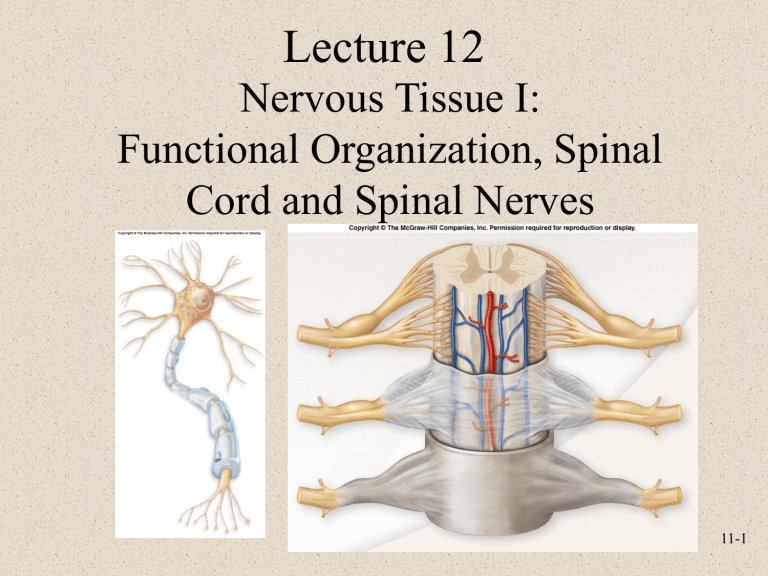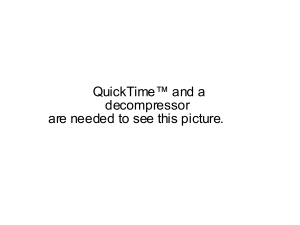Lecture 12 Nervous Tissue I: Functional Organization, Spinal Cord and Spinal Nerves

Lecture 12
Nervous Tissue I:
Functional Organization, Spinal
Cord and Spinal Nerves
11-1
Nervous Tissue
• Found in brain, spinal cord and nerves
• Property
– Ability to produce action potentials (electric signals)
•
Cells
–
Nerve cells or neurons
–
Neuroglia or support cells
– Oligodendrocytes and Schwann cells
11-2
The Nervous System
•
Subdivisions
–
Central nervous system ( CNS )
– Peripheral nervous system ( PNS )
•
Sensory receptor
–
Receptor of sensory information
• Nerve
– Made up of a bundle of axons
• Ganglion
– Collection of cell bodies of neurons
• Plexus
– Network of spinal nerves
11-3
Central Nervous System
Fig. 14.1
• Consists of
– Brain
• Located in cranial vault of skull
– Spinal cord
• Located in vertebral canal
•
Brain and spinal cord
–
Continuous with each other at foramen magnum
• Tract
11-4
Peripheral Nervous System
• Two subcategories
–
Sensory or afferent
–
Motor or efferent
• Divisions
– Somatic nervous system
–
Autonomic nervous system ( ANS )
» Sympathetic
(fight or flight)
» Parasympathetic
(rest and digest)
Fig. 14.2
11-5
Fig. 16.1
Spinal Cord
• Extends from foramen magnum to second lumbar vertebra
• Segmented
–
Cervical
–
Thoracic
–
Lumbar
–
Sacral
• Gives rise to 31 pairs of spinal nerves
• Not uniform in diameter throughout length
11-6
Meninges
• Connective tissue membranes surrounding spinal cord and brain
– Dura mater
–
Arachnoid mater
–
Pia mater
• Spaces
–
Epidural : Anesthesia injected
–
Subdural : Serous fluid
– Subarachnoid : cerebrospinal fluid (CSF)
11-7
Fig. 16.2
Cross Section of Spinal Cord
Fig. 16.3
• White matter
– Myelinated axons forming tracts
– Three funiculi (columns)
• Gray matter
– Neuron cell bodies, dendrites, axons
– Three horns
Fig. 16.4
11-8
Fig. 16.8
Spinal Nerves
Cervical Plexus
• C1-C4
• Phrenic nerve
– from C3-C5 (cervical and brachial plexus)
– innervates diaphragm
11-9
Fig. 16.9
Brachial Plexus
• C5-T1
• Major nerves
–
Radial
–
Ulnar
–
Median
11-10
Lumbar Plexus
Fig. 16.10
11-11
Fig. 16.11
Sacral Plexus
11-12
Review Question
Compression of the ________ nerve against the medial epicondyle of the humerus will produce strong tingling sensations along the forearm and hand.
(a) Radial
(b) Median
(c) Phrenic
(d) Femoral
(e) Ulnar
11-13
Points to Remember
• Nervous system consists of central nervous system
(brain and spinal cord) and peripheral nervous system (all nervous tissue outside of central nervous system)
• Sensory (afferent) neurons carry sensory information to brain and spinal cord
• Motor (efferent) neurons carry motor away from brain and spinal cord to spinal nerves and cranial nerves
• Spinal nerves have a dorsal root (sensory neurons) and a ventral root (motor neurons)
• Names of nerves in plexuses generally describe the body region they travel
11-14
Questions?
11-15





